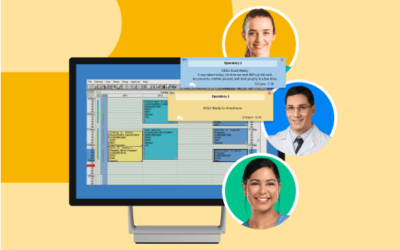
Communication in a dental practice is complex, including multiple channels each serving different purposes. To get a complete picture, consider the nature and requirements of the messages being exchanged. From intra-office banter to patient interactions, and from real-time problem-solving to long-term operational planning, each type of communication necessitates a distinct approach and set of tools.
Which Tool for Which Job?
Workplace Communication: This includes the day-to-day interactions among dental staff members, such as coordinating patient flow from reception to treatment rooms, discussing case details, or managing schedules. Tools for team communication need to be real-time and responsive, facilitating instant messaging and quick replies. They also need to support asynchronous messaging for non-urgent information that an employee can refer to at a later time. While Google Chat (or Google Meet, whatever they’re calling it these days) or Microsoft Teams are all capable of these types of interactions, it’s good to consider if the conversations will require specialized, HIPAA-compliant software.
Patient Communication: External communication with patients involves appointment reminders, treatment explanations, and follow-up care instructions. These require a more personalized approach, often utilizing phone calls for their one-on-one nature and the ability to convey empathy and understanding. Email also serves as a critical channel for providing detailed information that patients can review at their convenience.
Real-Time vs. Asynchronous: Some dental office conversations need immediate attention, such as a sudden change in the day’s schedule or an urgent patient query. Here, real-time internal communication tools like live chat or instant messaging are super valuable. Conversely, for topics that don’t necessitate an immediate response, such as policy changes or team meeting schedules, an asynchronous communication tool like email provides flexibility, allowing recipients to respond when they can give the matter full attention.
Long-Term Operational Communication: Discussions around practice management, such as equipment purchases, service expansions, or staff training programs, typically don’t fit into the daily communication flow. These require a repository of information and file sharing that can be accessed and built upon over time. Project management tools and shared digital workspaces can support these long-term conversations, allowing for collaborative planning and decision-making.
Security and Compliance: When patient information is involved, team communication tools must comply with privacy regulations like HIPAA. Secure messaging platforms designed for healthcare settings ensure that patient conversations are protected, offering peace of mind to both the practice and the individual.
Breaking down these effective workplace communication systems, it’s clear that no single tool is likely to meet every need within a dental practice. An ecosystem of solutions, each chosen for its strengths in a particular area, will provide the most comprehensive communication strategy.
Evaluating Communication Needs for Dental Teams
To create an environment where employee communication flows smoothly and securely, dental practices must assess their specific needs and the types of conversations that take place within their office. Here’s how to evaluate and address these needs effectively.
Determining Your Practice’s Communication Flow
– Audit Current Methods: Begin with an audit of your current internal communications tools and methods. Observe the flow of messages between staff and patients throughout the day to identify bottlenecks or security gaps.
– Staff Input: Gather input from team members about the communication tools they use, what they find effective, where they encounter challenges, and what would facilitate employee engagement. Front desk personnel, dental hygienists, and office managers may have different needs and insights.
– Patient Feedback: Collect feedback from patients on how they prefer to receive business communication from your practice. Some may value text message reminders, while others might prefer a phone call or email.
Crafting the Right Communication Mix
– Match Tools to Tasks: Align communication tools with specific tasks. Instant messaging (like Slack, Google Chat, or Google Hangouts) might be ideal for quick staff check-ins that don’t involve protected patient information, while a phone system with a comprehensive voicemail setup might be better suited for detailed patient communications.
– Asynchronous and Real-time Balance: Strike a balance between asynchronous and real-time tools. Consider an internal communication platform for real-time needs and a secure email system for messages that can wait.
– Technology Integration: Ensure that the communication tools integrate well with your dental practice’s technology stack, especially your Practice Management Software (PMS). This integration can streamline operations and reduce the need for duplicate data entry.
Integrating Communication Systems with Dental PMS
– Seamless Data Flow: Look for communication systems that allow for a seamless flow of information to and from your PMS. This can include patient records, appointment schedules, and billing information.
– Automation Features: Automation can enhance efficiency. Automated appointment reminders, patient recalls, and follow-up surveys can save staff time and improve patient relations.
– Compliance and Security: Ensure any system integrated with your PMS meets compliance standards. Data encryption, easy management of access control, and audit trails are essential features to protect patient information and comply with regulations.
Implementing Effective Communication Systems for Enhanced Patient Care
The effective implementation of a communication system like Yapi can transform a dental practice by bridging the gap between patient expectations and smooth operations.
Automated Patient Reminders and Confirmations
Yapi automates the process of patient reminders and confirmations, directly integrating with a dental practice’s PMS. It can send personalized reminders via multiple channels, helping to make sure that patients receive timely notifications in the manner they prefer. This level of personalization not only improves the patient experience but also has a major impact on reducing no-show rates.
Secure Patient Portals
With Yapi, dental practices can offer patients a secure portal where they can access their dental records, treatment plans, and appointment schedules. This not only creates open communication between your practice and the patient but also empowers them, giving them direct access to their health information and fostering a transparent doctor-patient relationship.
Feedback Systems for Enhanced Patient Care
Yapi provides intuitive tools for gathering patient feedback, which is important for any dental practice focused on continuous improvement. By leveraging Yapi’s survey capabilities, practices can collect and analyze patient feedback efficiently, allowing them to make informed adjustments to their service offerings.
Customized Training Programs for Staff
Recognizing that every dental practice operates differently, Yapi offers customized training programs to ensure that every team member can utilize its features effectively. Through interactive sessions and comprehensive support materials, dental staff can become proficient in managing employee communication software and practice workflows using Yapi.
Ongoing Support and Development
Yapi’s commitment to ongoing support ensures that dental practices can rely on timely assistance for any challenges that arise. Moreover, Yapi’s continual development means that new features and improvements are regularly introduced, keeping the communication system up-to-date with the latest technological advancements and industry best practices.
Appointment Follow-Up and Patient Satisfaction Tracking
The system’s ability to follow up on appointments helps practices gauge patient satisfaction and address any concerns proactively. By integrating these follow-ups with the PMS, Yapi ensures that all patient interactions are logged and tracked, providing a clear picture of the patient experience.
Referral Tracking for Practice Growth
Yapi’s communication system includes features for tracking referrals, which is useful for understanding how improved strategies impact practice growth. By analyzing referral sources and patient feedback, practices can fine-tune their marketing and patient retention strategies.
In harnessing the power of specialized communication technology like Yapi, dental practices can enhance their operational efficiency, improve patient satisfaction, and ensure compliance with healthcare standards. The use of such targeted technology solutions positions practices to meet current needs and adapt to future challenges in the healthcare communication arena.
How Yapi Addresses Many of These Needs
Integration with Practice Management Software
Yapi’s seamless integration with Dental Practice Management Software (PMS) is central to its effectiveness. It synchronizes patient information, appointments, and treatment notes in real-time, eliminating the need for manual data entry and the possibility of human error. This level of integration ensures that the entire dental team is on the same page regarding patient care and office scheduling.
Secure Messaging and Compliance
Security and compliance are a requirement in most healthcare communications. Yapi provides encrypted messaging that complies with HIPAA standards, ensuring patient information is protected. It also includes features for secure document sharing and e-signatures, which are crucial for maintaining treatment records and consent forms.
Automated Recall and Follow-Up Systems
Patient recalls are a major part of dental practice’s success. Yapi automates this process, sending timely reminders to patients due for follow-up care, which helps maintain a regular care schedule and maximizes chair time. These automated systems ensure that no patient falls through the cracks and that the practice can operate at optimal capacity.
Feedback and Reputation Management
Yapi facilitates the collection of patient feedback after appointments, which can be used to improve services. Additionally, satisfied patients can be encouraged to leave online reviews, which helps build the practice’s reputation and attract new patients.
Training and Support for Staff
Effective use of any communication system depends on proper training and support. Yapi offers comprehensive training modules to ensure that dental staff can utilize all features confidently. Ongoing customer support and updates are also provided, ensuring the practice can leverage new features as they become available.
Future-Proofing with Scalable Solutions
As dental practices grow, their communication needs evolve. Yapi’s scalable solutions can accommodate an increasing number of patients and an expanding team, ensuring the system grows with the practice. This adaptability is crucial for long-term investment in communication technology.
In summary, leveraging specialized communication tools like Yapi can significantly enhance the efficiency and effectiveness of dental practice operations. By providing a comprehensive suite of features designed to meet the unique demands of the dental industry, Yapi stands as a testament to the power of purpose-built solutions in streamlining communication and improving patient care.
Creating Your Communication Ecosystem
Below we’ve provided an exhaustive audit of different communication needs for a dental office. We’ve marked if the communication requires HIPAA considerations and compliance, how frequent that communication need is, and whether Yapi can directly handle that need.
Patient-Related Communication |
|||
| Communication Need | HIPAA Compliance? | Frequency | Yapi |
| Appointment scheduling and confirmations | Yes | Daily | Yes |
| Treatment plan discussions | Yes | Daily | Yes |
| Post-treatment care instructions | Yes | Daily | Yes |
| Emergency dental care coordination | Yes | As needed | No |
| Insurance and billing inquiries | Yes | Daily | No |
| Follow-up calls for check-ups and recalls | Yes | Daily | Yes |
| Procedural consent discussions | Yes | As needed | Yes |
| Patient education on oral health | Yes | Daily | Yes |
| Feedback collection and satisfaction surveys | Yes | Regularly | Yes |
| Seasonal greetings and birthday wishes | No | Occasionally | No |
| Reminders for incomplete treatments | Yes | Regularly | Yes |
| Notifications about new services or promotions | No | Occasionally | Yes |
Inner-Office Communication |
|||
| Communication Need | HIPAA Compliance? | Frequency | Yapi |
| Staff meetings and briefings | No | Weekly | No |
| Shift handovers and daily task delegations | No | Daily | Yes |
| Clinical team discussions on patient cases | Yes | Daily | Yes |
| Real-time alerts about patient arrivals or delays | Yes | Constantly | Yes |
| Administrative announcements | No | Regularly | No |
| Coordination of lunch breaks and time-offs | No | Daily | No |
| Equipment and inventory updates | No | Regularly | No |
| Compliance and regulatory updates | Yes | As needed | No |
| Intra-office memos and bulletins | No | Regularly | No |
| Emergency protocol briefings | No | As needed | No |
| Cross-departmental collaborations | No | As needed | No |
| Training sessions and professional development updates | No | Periodically | No |
Operational Communication |
|||
| Communication Need | HIPAA Compliance? | Frequency | Yapi |
| Supplier and vendor negotiations | No | As needed | No |
| Maintenance and service scheduling for equipment | No | Regularly | No |
| Interactions with dental labs for case work | Yes | Regularly | No |
| Discussions regarding office policies and procedures | No | Regularly | No |
| Strategic planning meetings | No | As needed | No |
| Financial reporting and accounting communications | No | Monthly | No |
| Marketing campaign planning and execution | No | As needed | No |
| IT support and troubleshooting | No | As needed | No |
| Legal and regulatory correspondence | Yes | As needed | No |
| Community outreach and public relations | No | As needed | No |
Digital and Online Communication |
|||
| Communication Need | HIPAA Compliance? | Frequency | Yapi |
| Website updates and content management | No | Regularly | No |
| Social media postings and interactions | No | Regularly | No |
| Email newsletters to patients | Yes | Monthly | Yes |
| Online reputation and review management | No | Regularly | No |
| Tele-dentistry consultations | Yes | As needed | No |
| Virtual team collaborations | No | Daily | No |
| Data entry and record-keeping in digital systems | Yes | Daily | Yes |
| Online training and webinars | No | Periodically | No |
Compliance and Privacy Communication |
|||
| Communication Need | HIPAA Compliance? | Frequency | Yapi |
| HIPAA-compliant information sharing | Yes | Constantly | Yes |
| Patient privacy and data security briefings | Yes | Periodically | No |
| Updates on changes in healthcare laws and regulations | Yes | Periodically | No |
| Compliance audit discussions | Yes | Annually/As needed | No |
| Training on patient confidentiality protocols | Yes | Annually/As needed | No |
Emergency and Unplanned Communication |
|||
| Communication Need | HIPAA Compliance? | Frequency | Yapi |
| Immediate responses to patient emergencies | Yes | As needed | Yes |
| Unforeseen cancellations or rescheduling | Yes | As needed | Yes |
| Rapid notifications in case of office closure (e.g., due to weather) | No | As needed | Yes |
| Critical updates on public health issues affecting operations | No | As needed | No |



